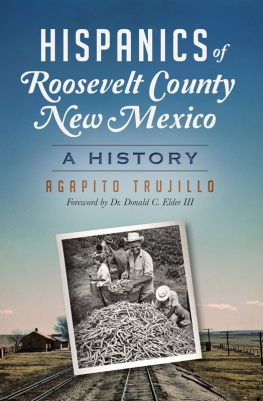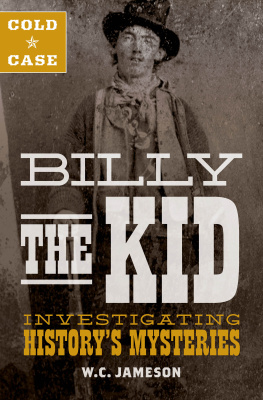New Mexico Episodes
Stories from a Colorful Past
John Philip Wilson
Dedication
For Albert H. Schroeder, long-time National Park Service archaeologist and researcher, who inspired others.
~ Preface ~
T hirteen episodes in New Mexicos long history are explored here to give insights into the wide variety of events that helped weave the rich tapestry of this states past. We meet the very first European explorer and learn something of what he was told by the natives. Later we learn what became of a settlers house that still bore his name two hundred years after he left it. After 1846, miners, ranchers and others began to explore the country away from the Rio Grande and, within a generation, travelers were crossing the territory via stagecoach while occasionally being the victims of knights of the road, who made their living by preying on passengers.
The military played an important role in nineteenth century New Mexico, and we see something of what life was like at a Civil War-era Army post, as well as glimpsing southeastern New Mexico when its only inhabitants were Apache Indians. Even in the settled areas, systems we now take for granted such as mail delivery and communicating with the world outside were handled very differently than today.
Little-known aspects of New Mexicos best-known badman, Billy the Kid, still lurk in the byways of the past, while for those not already familiar with it, the controversial and bloody history of the year-long conflict known as the Lincoln County War is sketched out. Nor was this violence unique to Lincoln County, as an account from Grant County in western New Mexico shows. Much later, during World War I, an enemy saboteur working for Emperor Franz-Joseph I of Austria-Hungary was apprehended by a U.S. Forest Service ranger. And like all good anthologies, there is a dog story.
These chapters came together at the suggestion of a good friend and highly-respected historian, Dr. Harwood Hinton. Early in 1985, after I received a contract with a state agency to write a history of the Lincoln County War, I decided to begin my research by reviewing the Maurice Fulton Papers now housed at the University of Arizona Special Collections Library. At that time Dr. Hinton, whom I did not know, had an office in the main library building. He customarily swooped down to the special collections reading room and took whatever scholars were at work there to lunch at the faculty dining rooms across the campus. I was one of the swoopees and very much enjoyed the companionship and conversations, as well as the lunches.
I told him that I was at a loss to know how I should orient my history of this already-overwritten subject. Harwood, who was most familiar with it from his own research, said Well, you know what they said about [President] Nixonfollow the money! That struck me, and that was what I didthe Lincoln County War as a battle for economic dominance!
A decade or so later, I was back in Tucson for another project and mentioned to Harwood that I had no good ideas for another writing project. This time he said, why dont you compile some of the non-fiction stories that youve scattered here and there, mostly in journals or newsletters that historians usually dont see, rewrite these and make them into a book? Again, a suggestion worth considering. Several years later, after I had retired, I took him up on this idea. The present book is one of the results!
How all of these chapters came to be written is a different story for each. The one about the saboteur originated with a reminiscence by former ranger Elliott Barker, published in a three-volume Forest Service compilation called The Early Days: Books 1-3. The story about the seventeenth-century settler Felipe Romero grew out of my reading the testimonies in the Sevilleta Land Grant microfilm, which I had been searching for any references to archaeological remains. The Lincoln County War and Billy the Kid articles are spin-offs from my 1987 book, Merchants, Guns & Money. The Fort McRae piece and Captain Claibornes report had their start when I spotted the brief journal and various accounts of Army scouting parties among the documents in the Schroeder Collection at the New Mexico State Records Center and Archives.
Some of the other articles derive from my reading countless microfilms of nineteenth-century New Mexico newspapers. The Marata chapter is based upon my website about the kingdom of Marata, which in turn grew out of my disappointment with both historians and archaeologists about their lack of any effort to confirm the existence of such a site, whose general location had been cited by the friar Marcos de Niza but never actually visited. Finding Marata turned out to be fairly straightforward, and the Zuni Indian traditions about it (under different names), as recorded by early-day anthropologists, fell into place. Its walls still stood four feet high in the 1880s.
There are no necessary connections between any of these short narratives. They were drafted originally over a period of almost forty years, and about half have not been previously published. For the most part, acknowledgements are owing to Drs. Hinton and Albert H. Schroeder, with thanks also to the rancher who allowed me to complete my mapping of the Marata ruin.
The articles that have seen print before are rewritten here, sometimes with many changes and additions from the original drafts. Readers are invited to pick and choose; the texts are of various lengths and, as said, cover a wide variety of topics. For the most part, they have been chosen to represent aspects of New Mexicos history not explored elsewhere. They are given here as entertainment and perhaps will inspire others to do new research, which in turn may help flesh out what we already know. I hope that they appeal to anyone with an interest in New Mexico history. Original research is always a challenge, but it can be immensely rewarding.
1. Some Locations for New Mexico Episodes . Map by the author.
~ 1 ~ Marata, A New Mexico Kingdom (With Notes on Totonteac)
In the spring of 1539, Antonio de Mendoza, the viceroy of New Spain, sent the Franciscan friar Marcos de Niza on a mission to find a route northward beyond the settled limits of New Spain. He was to determine the nature of the lands and the people, and to gather information about the western coastline. Fray Marcos set off, and after passing the last Spanish settlements he sent one of his companions, Esteban de Dorantes, in advance to see if a rich and settled land might lie beyond.
Within days, Esteban sent back word that thirty days ahead lay seven very great ciudades or cities, ruled by a single lord. The first and greatest was called Cibola. He had talked with natives who told him that besides the seven cities, there were three other reinos or kingdoms called Maratta, Acus, and Totonteac. These names were all new and no maps of the period showed their locations. Fray Marcos was still well down in modern Sonora.
The priest continued four days through a despoblado or unoccupied region that would probably have included the San Rafael Valley in southern Arizona. Soon he arrived at a heavily settled area with clusters of houses a mile or so apart. While he gave no name to this place or its people, a modern estimate is that he was now in the San Pedro Valley of southern Arizona, among the Indians known later as Sobaipuris.
These people gave the good father a wealth of information about the seven cities. Even before this, Indians had shown him shields made of cueros de vaca, or cow-hides, which came from Cibola. These cow-hides were the skins of bison which in the Zuni Indian language are called ciwolos. In Spanish, this became cibolos or civolos, and the name came into use for the whole province of Cibola.





